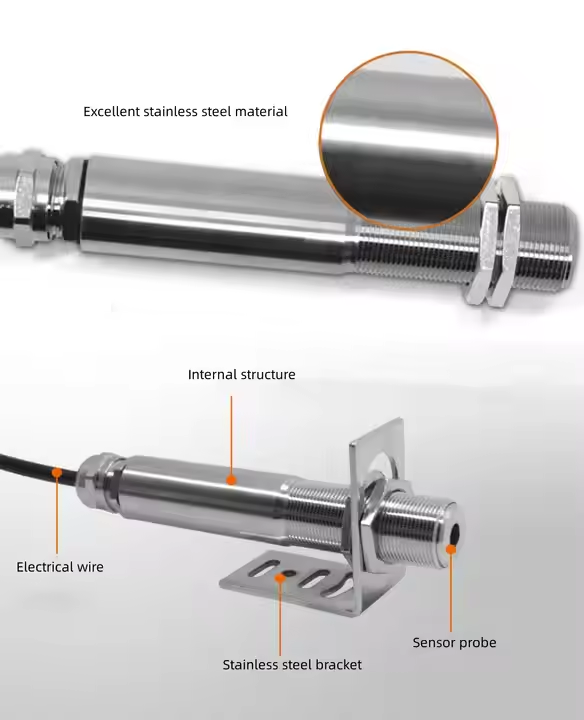Introduction to infrared temperature sensor
Infrared temperature sensor is a non-contact sensor that uses infrared radiation energy released by an object to measure surface temperature. Its core principle is based on the Stefan-Boltzmann law: all objects with a temperature above absolute zero will radiate infrared rays, and the radiation intensity is proportional to the fourth power of the surface temperature of the object. The sensor converts the received infrared radiation into an electrical signal through a built-in thermopile or pyroelectric detector, and then calculates the temperature value through an algorithm.
Technical features:
Non-contact measurement: no need to contact the object being measured, avoiding contamination or interference with high temperature and moving targets.
Fast response speed: millisecond response, suitable for dynamic temperature monitoring.
Wide range: typical coverage -50℃ to 3000℃ (different models vary greatly).
Strong adaptability: can be used in vacuum, corrosive environment or electromagnetic interference scenarios.
Core technical indicators
Measurement accuracy: ±1% or ±1.5℃ (high-end industrial grade can reach ±0.3℃)
Emissivity adjustment: supports 0.1~1.0 adjustable (calibrated for different material surfaces)
Optical resolution: For example, 30:1 means that a 1cm diameter area can be measured at a distance of 30cm
Response wavelength: Common 8~14μm (suitable for objects at normal temperature), short-wave type is used for high temperature detection
Typical application cases
1. Predictive maintenance of industrial equipment
A certain automobile manufacturer installed MLX90614 infrared array sensors at the motor bearings, and predicted faults by continuously monitoring the bearing temperature changes and combining AI algorithms. Practical data shows that warning of bearing overheating failures 72 hours in advance can reduce downtime losses by 230,000 US dollars per year.
2. Medical temperature screening system
During the 2020 COVID-19 pandemic, FLIR T series thermal imagers were deployed at the emergency entrance of hospitals, achieving abnormal temperature screening of 20 people per second, with a temperature measurement error of ≤0.3℃, and combined with face recognition technology to achieve abnormal temperature personnel trajectory tracking.
3. Smart home appliance temperature control
The high-end induction cooker integrates the Melexis MLX90621 infrared sensor to monitor the temperature distribution of the bottom of the pot in real time. When local overheating (such as empty burning) is detected, the power is automatically reduced. Compared with the traditional thermocouple solution, the temperature control response speed is increased by 5 times.
4. Agricultural precision irrigation system
A farm in Israel uses Heimann HTPA32x32 infrared thermal imager to monitor the temperature of crop canopy and build a transpiration model based on environmental parameters. The system automatically adjusts the drip irrigation volume, saving 38% of water in the vineyard while increasing production by 15%.
5. Online monitoring of power systems
The State Grid deploys Optris PI series online infrared thermometers in high-voltage substations to monitor the temperature of key parts such as busbar joints and insulators 24 hours a day. In 2022, a substation successfully warned of poor contact of 110kV disconnectors, avoiding a regional power outage.
Innovative development trends
Multi-spectral fusion technology: Combine infrared temperature measurement with visible light images to improve target recognition capabilities in complex scenarios
AI temperature field analysis: Analyze temperature distribution characteristics based on deep learning, such as automatic labeling of inflammatory areas in the medical field
MEMS miniaturization: The AS6221 sensor launched by AMS is only 1.5×1.5mm in size and can be embedded in smart watches to monitor skin temperature
Wireless Internet of Things integration: LoRaWAN protocol infrared temperature measurement nodes achieve kilometer-level remote monitoring, suitable for oil pipeline monitoring
Selection suggestions
Food processing line: Prioritize models with IP67 protection level and response time <100ms
Laboratory research: Pay attention to 0.01℃ temperature resolution and data output interface (such as USB/I2C)
Fire protection applications: Select explosion-proof sensors with a range of more than 600℃, equipped with smoke penetration filters
With the popularization of 5G and edge computing technologies, infrared temperature sensors are developing from single measurement tools to intelligent sensing nodes, showing greater application potential in fields such as Industry 4.0 and smart cities.
Post time: Feb-11-2025


